MNG81001: Media Relations and its Impact on Corporate Communication
VerifiedAdded on 2023/03/31
|11
|2093
|276
Report
AI Summary
This report analyzes the role of media relations in corporate organizations, emphasizing its significance in corporate communication. It discusses how media serves as a crucial medium for stakeholders to gather information about a company's services and reputation. The report highlights the importance of establishing strong media relations, the challenges faced by organizations in managing media interactions, and the impact of media use on product and service development. It also addresses issues such as management's hesitation in dealing with the media and the need for effective communication strategies, particularly in crisis situations. The report concludes that leveraging media relations, especially through social media, can enhance organizational innovation and performance, provided it is supported by a clear strategy and adequate competence.
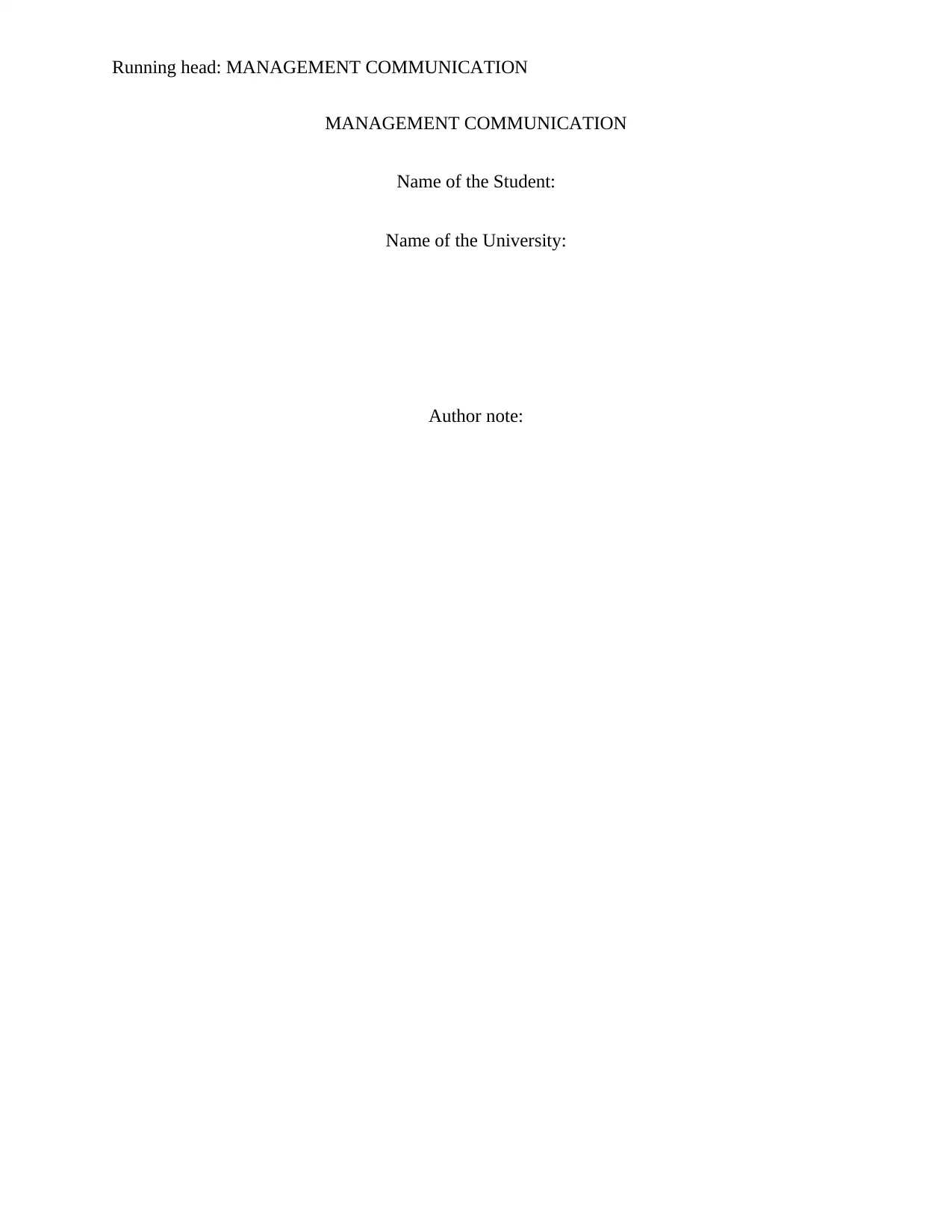
Running head: MANAGEMENT COMMUNICATION
MANAGEMENT COMMUNICATION
Name of the Student:
Name of the University:
Author note:
MANAGEMENT COMMUNICATION
Name of the Student:
Name of the University:
Author note:
Paraphrase This Document
Need a fresh take? Get an instant paraphrase of this document with our AI Paraphraser
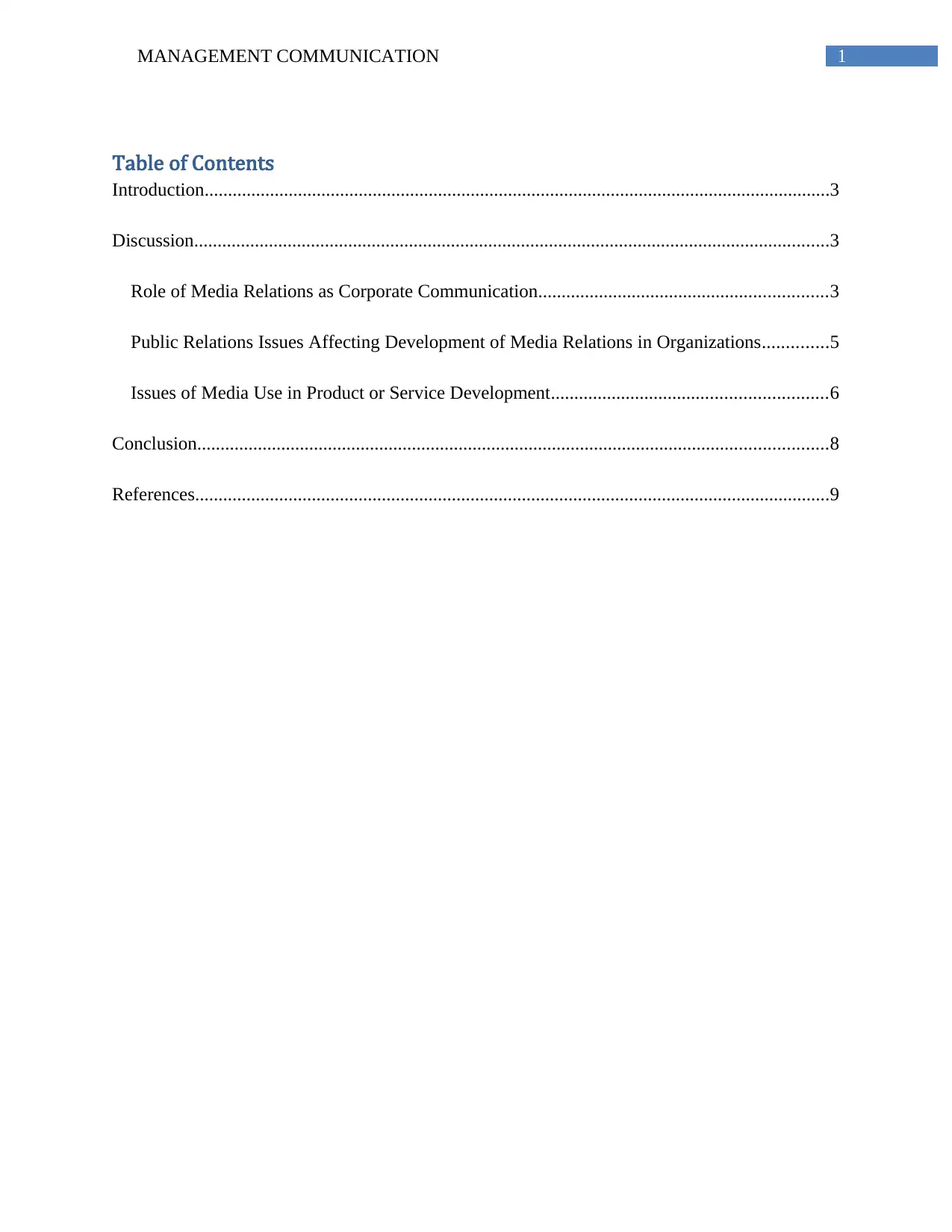
1MANAGEMENT COMMUNICATION
Table of Contents
Introduction......................................................................................................................................3
Discussion........................................................................................................................................3
Role of Media Relations as Corporate Communication..............................................................3
Public Relations Issues Affecting Development of Media Relations in Organizations..............5
Issues of Media Use in Product or Service Development...........................................................6
Conclusion.......................................................................................................................................8
References........................................................................................................................................9
Table of Contents
Introduction......................................................................................................................................3
Discussion........................................................................................................................................3
Role of Media Relations as Corporate Communication..............................................................3
Public Relations Issues Affecting Development of Media Relations in Organizations..............5
Issues of Media Use in Product or Service Development...........................................................6
Conclusion.......................................................................................................................................8
References........................................................................................................................................9
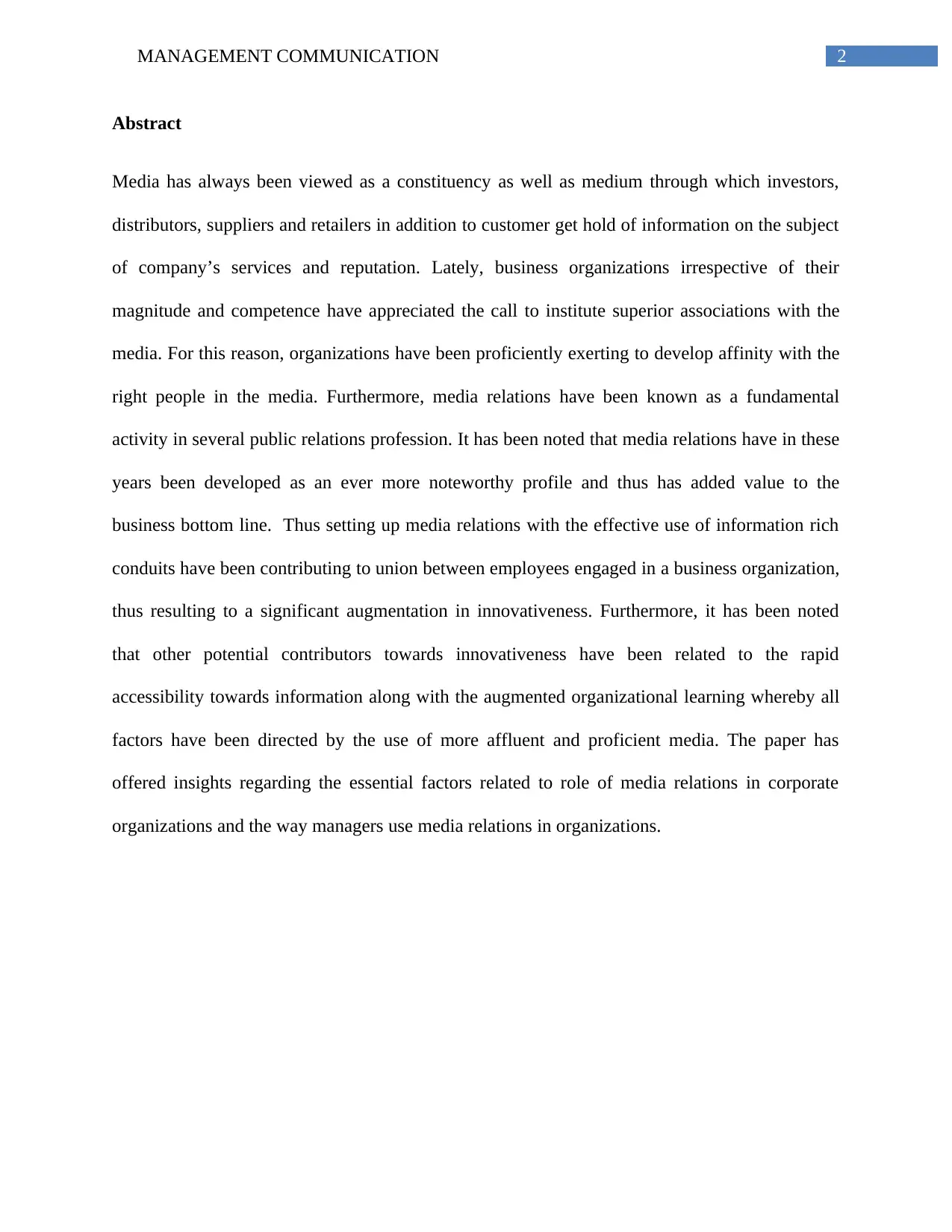
2MANAGEMENT COMMUNICATION
Abstract
Media has always been viewed as a constituency as well as medium through which investors,
distributors, suppliers and retailers in addition to customer get hold of information on the subject
of company’s services and reputation. Lately, business organizations irrespective of their
magnitude and competence have appreciated the call to institute superior associations with the
media. For this reason, organizations have been proficiently exerting to develop affinity with the
right people in the media. Furthermore, media relations have been known as a fundamental
activity in several public relations profession. It has been noted that media relations have in these
years been developed as an ever more noteworthy profile and thus has added value to the
business bottom line. Thus setting up media relations with the effective use of information rich
conduits have been contributing to union between employees engaged in a business organization,
thus resulting to a significant augmentation in innovativeness. Furthermore, it has been noted
that other potential contributors towards innovativeness have been related to the rapid
accessibility towards information along with the augmented organizational learning whereby all
factors have been directed by the use of more affluent and proficient media. The paper has
offered insights regarding the essential factors related to role of media relations in corporate
organizations and the way managers use media relations in organizations.
Abstract
Media has always been viewed as a constituency as well as medium through which investors,
distributors, suppliers and retailers in addition to customer get hold of information on the subject
of company’s services and reputation. Lately, business organizations irrespective of their
magnitude and competence have appreciated the call to institute superior associations with the
media. For this reason, organizations have been proficiently exerting to develop affinity with the
right people in the media. Furthermore, media relations have been known as a fundamental
activity in several public relations profession. It has been noted that media relations have in these
years been developed as an ever more noteworthy profile and thus has added value to the
business bottom line. Thus setting up media relations with the effective use of information rich
conduits have been contributing to union between employees engaged in a business organization,
thus resulting to a significant augmentation in innovativeness. Furthermore, it has been noted
that other potential contributors towards innovativeness have been related to the rapid
accessibility towards information along with the augmented organizational learning whereby all
factors have been directed by the use of more affluent and proficient media. The paper has
offered insights regarding the essential factors related to role of media relations in corporate
organizations and the way managers use media relations in organizations.
⊘ This is a preview!⊘
Do you want full access?
Subscribe today to unlock all pages.

Trusted by 1+ million students worldwide
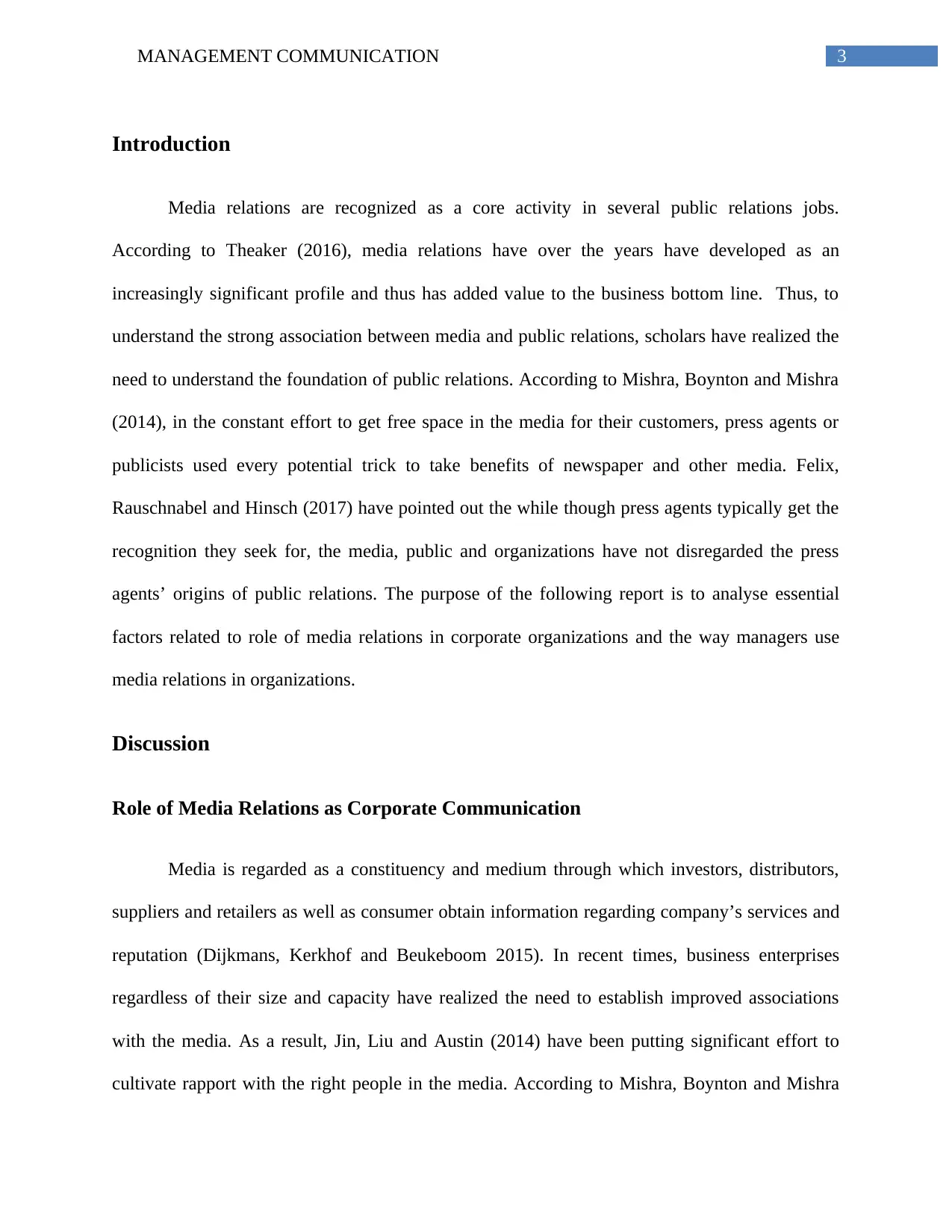
3MANAGEMENT COMMUNICATION
Introduction
Media relations are recognized as a core activity in several public relations jobs.
According to Theaker (2016), media relations have over the years have developed as an
increasingly significant profile and thus has added value to the business bottom line. Thus, to
understand the strong association between media and public relations, scholars have realized the
need to understand the foundation of public relations. According to Mishra, Boynton and Mishra
(2014), in the constant effort to get free space in the media for their customers, press agents or
publicists used every potential trick to take benefits of newspaper and other media. Felix,
Rauschnabel and Hinsch (2017) have pointed out the while though press agents typically get the
recognition they seek for, the media, public and organizations have not disregarded the press
agents’ origins of public relations. The purpose of the following report is to analyse essential
factors related to role of media relations in corporate organizations and the way managers use
media relations in organizations.
Discussion
Role of Media Relations as Corporate Communication
Media is regarded as a constituency and medium through which investors, distributors,
suppliers and retailers as well as consumer obtain information regarding company’s services and
reputation (Dijkmans, Kerkhof and Beukeboom 2015). In recent times, business enterprises
regardless of their size and capacity have realized the need to establish improved associations
with the media. As a result, Jin, Liu and Austin (2014) have been putting significant effort to
cultivate rapport with the right people in the media. According to Mishra, Boynton and Mishra
Introduction
Media relations are recognized as a core activity in several public relations jobs.
According to Theaker (2016), media relations have over the years have developed as an
increasingly significant profile and thus has added value to the business bottom line. Thus, to
understand the strong association between media and public relations, scholars have realized the
need to understand the foundation of public relations. According to Mishra, Boynton and Mishra
(2014), in the constant effort to get free space in the media for their customers, press agents or
publicists used every potential trick to take benefits of newspaper and other media. Felix,
Rauschnabel and Hinsch (2017) have pointed out the while though press agents typically get the
recognition they seek for, the media, public and organizations have not disregarded the press
agents’ origins of public relations. The purpose of the following report is to analyse essential
factors related to role of media relations in corporate organizations and the way managers use
media relations in organizations.
Discussion
Role of Media Relations as Corporate Communication
Media is regarded as a constituency and medium through which investors, distributors,
suppliers and retailers as well as consumer obtain information regarding company’s services and
reputation (Dijkmans, Kerkhof and Beukeboom 2015). In recent times, business enterprises
regardless of their size and capacity have realized the need to establish improved associations
with the media. As a result, Jin, Liu and Austin (2014) have been putting significant effort to
cultivate rapport with the right people in the media. According to Mishra, Boynton and Mishra
Paraphrase This Document
Need a fresh take? Get an instant paraphrase of this document with our AI Paraphraser
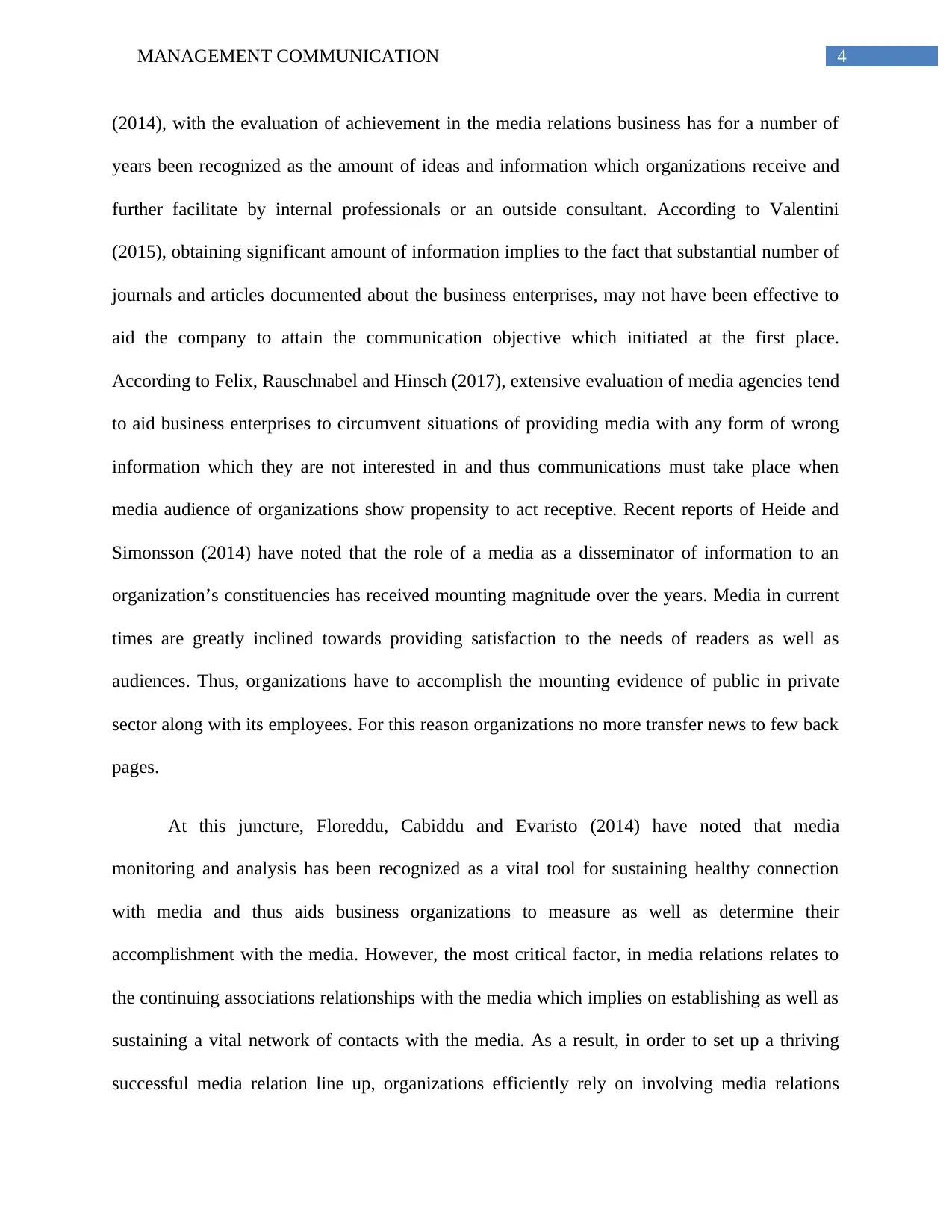
4MANAGEMENT COMMUNICATION
(2014), with the evaluation of achievement in the media relations business has for a number of
years been recognized as the amount of ideas and information which organizations receive and
further facilitate by internal professionals or an outside consultant. According to Valentini
(2015), obtaining significant amount of information implies to the fact that substantial number of
journals and articles documented about the business enterprises, may not have been effective to
aid the company to attain the communication objective which initiated at the first place.
According to Felix, Rauschnabel and Hinsch (2017), extensive evaluation of media agencies tend
to aid business enterprises to circumvent situations of providing media with any form of wrong
information which they are not interested in and thus communications must take place when
media audience of organizations show propensity to act receptive. Recent reports of Heide and
Simonsson (2014) have noted that the role of a media as a disseminator of information to an
organization’s constituencies has received mounting magnitude over the years. Media in current
times are greatly inclined towards providing satisfaction to the needs of readers as well as
audiences. Thus, organizations have to accomplish the mounting evidence of public in private
sector along with its employees. For this reason organizations no more transfer news to few back
pages.
At this juncture, Floreddu, Cabiddu and Evaristo (2014) have noted that media
monitoring and analysis has been recognized as a vital tool for sustaining healthy connection
with media and thus aids business organizations to measure as well as determine their
accomplishment with the media. However, the most critical factor, in media relations relates to
the continuing associations relationships with the media which implies on establishing as well as
sustaining a vital network of contacts with the media. As a result, in order to set up a thriving
successful media relation line up, organizations efficiently rely on involving media relations
(2014), with the evaluation of achievement in the media relations business has for a number of
years been recognized as the amount of ideas and information which organizations receive and
further facilitate by internal professionals or an outside consultant. According to Valentini
(2015), obtaining significant amount of information implies to the fact that substantial number of
journals and articles documented about the business enterprises, may not have been effective to
aid the company to attain the communication objective which initiated at the first place.
According to Felix, Rauschnabel and Hinsch (2017), extensive evaluation of media agencies tend
to aid business enterprises to circumvent situations of providing media with any form of wrong
information which they are not interested in and thus communications must take place when
media audience of organizations show propensity to act receptive. Recent reports of Heide and
Simonsson (2014) have noted that the role of a media as a disseminator of information to an
organization’s constituencies has received mounting magnitude over the years. Media in current
times are greatly inclined towards providing satisfaction to the needs of readers as well as
audiences. Thus, organizations have to accomplish the mounting evidence of public in private
sector along with its employees. For this reason organizations no more transfer news to few back
pages.
At this juncture, Floreddu, Cabiddu and Evaristo (2014) have noted that media
monitoring and analysis has been recognized as a vital tool for sustaining healthy connection
with media and thus aids business organizations to measure as well as determine their
accomplishment with the media. However, the most critical factor, in media relations relates to
the continuing associations relationships with the media which implies on establishing as well as
sustaining a vital network of contacts with the media. As a result, in order to set up a thriving
successful media relation line up, organizations efficiently rely on involving media relations
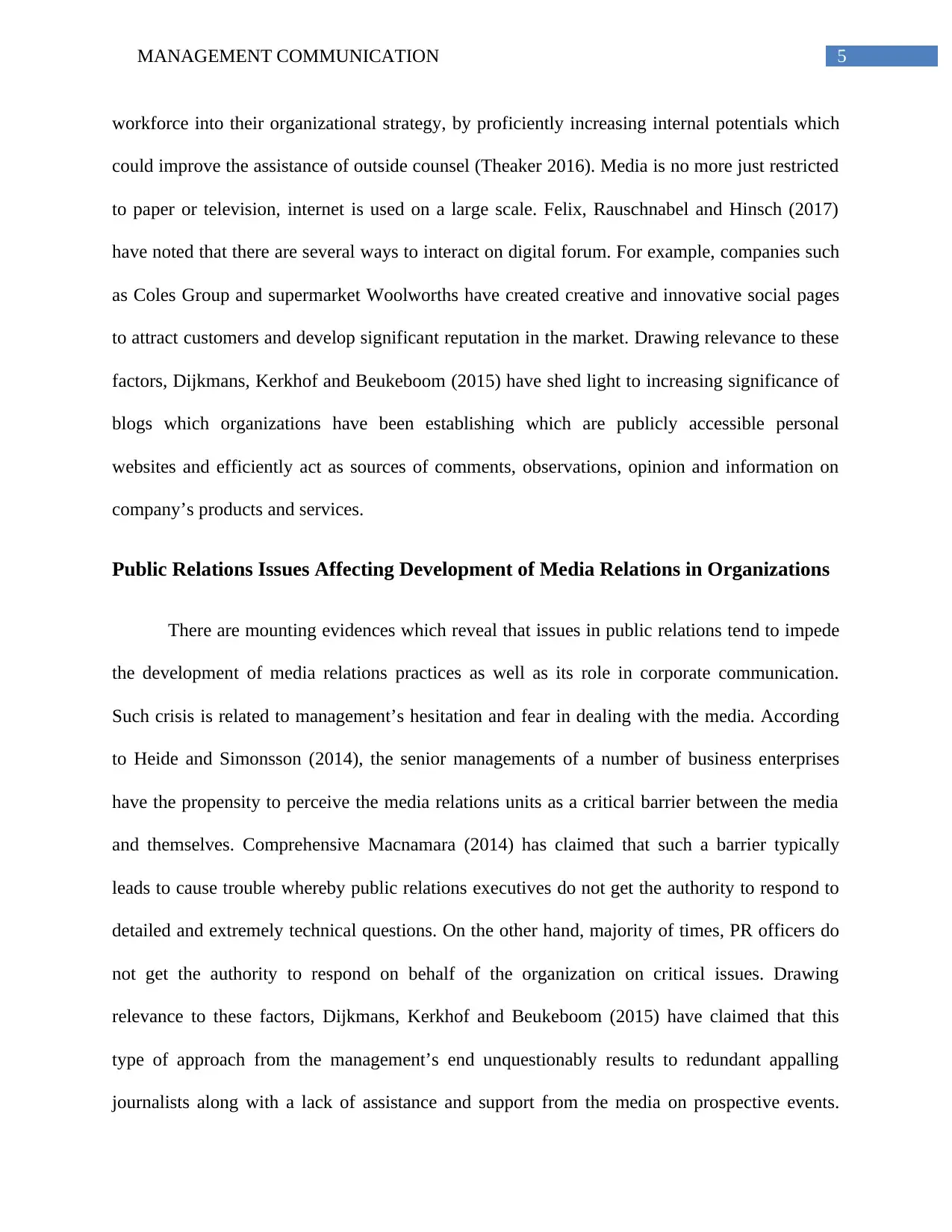
5MANAGEMENT COMMUNICATION
workforce into their organizational strategy, by proficiently increasing internal potentials which
could improve the assistance of outside counsel (Theaker 2016). Media is no more just restricted
to paper or television, internet is used on a large scale. Felix, Rauschnabel and Hinsch (2017)
have noted that there are several ways to interact on digital forum. For example, companies such
as Coles Group and supermarket Woolworths have created creative and innovative social pages
to attract customers and develop significant reputation in the market. Drawing relevance to these
factors, Dijkmans, Kerkhof and Beukeboom (2015) have shed light to increasing significance of
blogs which organizations have been establishing which are publicly accessible personal
websites and efficiently act as sources of comments, observations, opinion and information on
company’s products and services.
Public Relations Issues Affecting Development of Media Relations in Organizations
There are mounting evidences which reveal that issues in public relations tend to impede
the development of media relations practices as well as its role in corporate communication.
Such crisis is related to management’s hesitation and fear in dealing with the media. According
to Heide and Simonsson (2014), the senior managements of a number of business enterprises
have the propensity to perceive the media relations units as a critical barrier between the media
and themselves. Comprehensive Macnamara (2014) has claimed that such a barrier typically
leads to cause trouble whereby public relations executives do not get the authority to respond to
detailed and extremely technical questions. On the other hand, majority of times, PR officers do
not get the authority to respond on behalf of the organization on critical issues. Drawing
relevance to these factors, Dijkmans, Kerkhof and Beukeboom (2015) have claimed that this
type of approach from the management’s end unquestionably results to redundant appalling
journalists along with a lack of assistance and support from the media on prospective events.
workforce into their organizational strategy, by proficiently increasing internal potentials which
could improve the assistance of outside counsel (Theaker 2016). Media is no more just restricted
to paper or television, internet is used on a large scale. Felix, Rauschnabel and Hinsch (2017)
have noted that there are several ways to interact on digital forum. For example, companies such
as Coles Group and supermarket Woolworths have created creative and innovative social pages
to attract customers and develop significant reputation in the market. Drawing relevance to these
factors, Dijkmans, Kerkhof and Beukeboom (2015) have shed light to increasing significance of
blogs which organizations have been establishing which are publicly accessible personal
websites and efficiently act as sources of comments, observations, opinion and information on
company’s products and services.
Public Relations Issues Affecting Development of Media Relations in Organizations
There are mounting evidences which reveal that issues in public relations tend to impede
the development of media relations practices as well as its role in corporate communication.
Such crisis is related to management’s hesitation and fear in dealing with the media. According
to Heide and Simonsson (2014), the senior managements of a number of business enterprises
have the propensity to perceive the media relations units as a critical barrier between the media
and themselves. Comprehensive Macnamara (2014) has claimed that such a barrier typically
leads to cause trouble whereby public relations executives do not get the authority to respond to
detailed and extremely technical questions. On the other hand, majority of times, PR officers do
not get the authority to respond on behalf of the organization on critical issues. Drawing
relevance to these factors, Dijkmans, Kerkhof and Beukeboom (2015) have claimed that this
type of approach from the management’s end unquestionably results to redundant appalling
journalists along with a lack of assistance and support from the media on prospective events.
⊘ This is a preview!⊘
Do you want full access?
Subscribe today to unlock all pages.

Trusted by 1+ million students worldwide
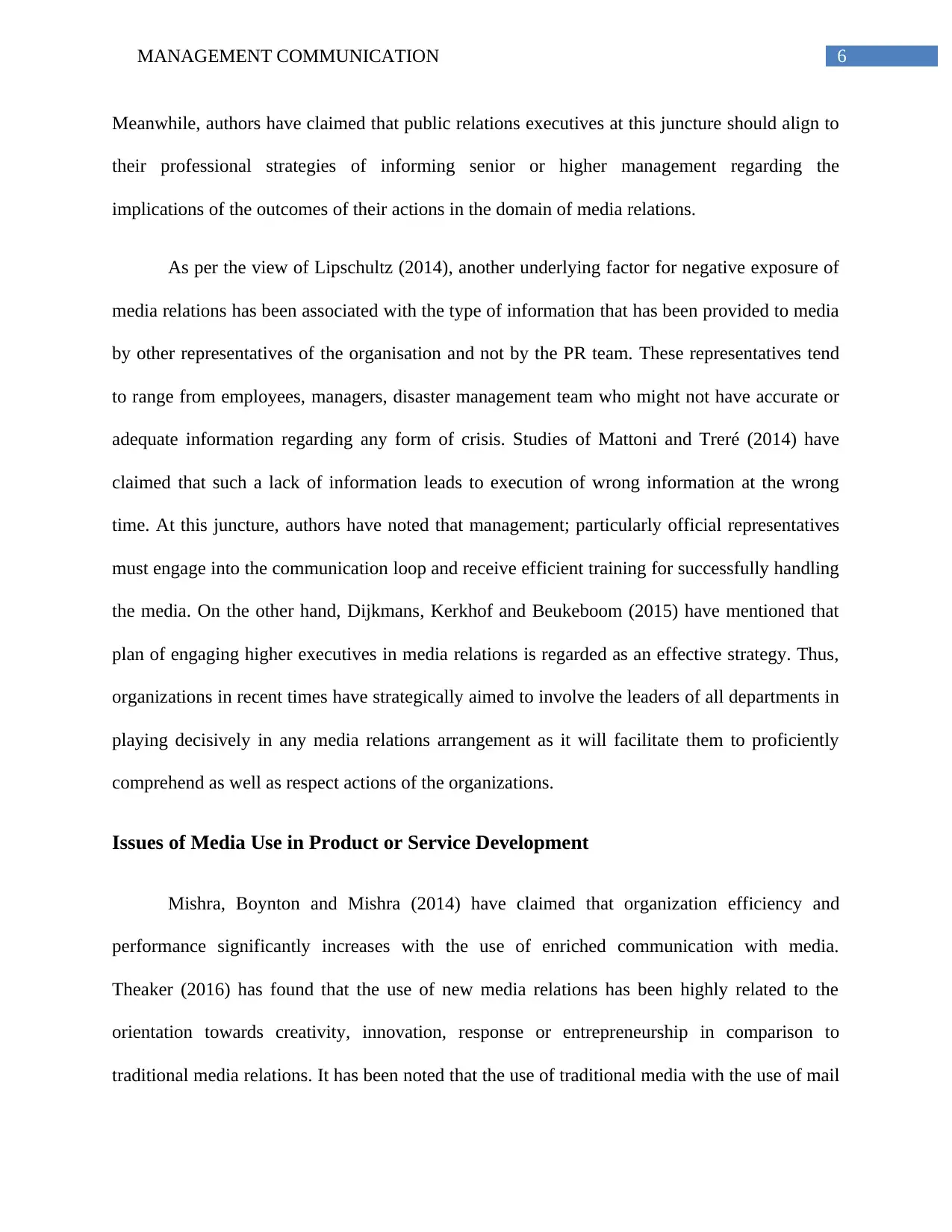
6MANAGEMENT COMMUNICATION
Meanwhile, authors have claimed that public relations executives at this juncture should align to
their professional strategies of informing senior or higher management regarding the
implications of the outcomes of their actions in the domain of media relations.
As per the view of Lipschultz (2014), another underlying factor for negative exposure of
media relations has been associated with the type of information that has been provided to media
by other representatives of the organisation and not by the PR team. These representatives tend
to range from employees, managers, disaster management team who might not have accurate or
adequate information regarding any form of crisis. Studies of Mattoni and Treré (2014) have
claimed that such a lack of information leads to execution of wrong information at the wrong
time. At this juncture, authors have noted that management; particularly official representatives
must engage into the communication loop and receive efficient training for successfully handling
the media. On the other hand, Dijkmans, Kerkhof and Beukeboom (2015) have mentioned that
plan of engaging higher executives in media relations is regarded as an effective strategy. Thus,
organizations in recent times have strategically aimed to involve the leaders of all departments in
playing decisively in any media relations arrangement as it will facilitate them to proficiently
comprehend as well as respect actions of the organizations.
Issues of Media Use in Product or Service Development
Mishra, Boynton and Mishra (2014) have claimed that organization efficiency and
performance significantly increases with the use of enriched communication with media.
Theaker (2016) has found that the use of new media relations has been highly related to the
orientation towards creativity, innovation, response or entrepreneurship in comparison to
traditional media relations. It has been noted that the use of traditional media with the use of mail
Meanwhile, authors have claimed that public relations executives at this juncture should align to
their professional strategies of informing senior or higher management regarding the
implications of the outcomes of their actions in the domain of media relations.
As per the view of Lipschultz (2014), another underlying factor for negative exposure of
media relations has been associated with the type of information that has been provided to media
by other representatives of the organisation and not by the PR team. These representatives tend
to range from employees, managers, disaster management team who might not have accurate or
adequate information regarding any form of crisis. Studies of Mattoni and Treré (2014) have
claimed that such a lack of information leads to execution of wrong information at the wrong
time. At this juncture, authors have noted that management; particularly official representatives
must engage into the communication loop and receive efficient training for successfully handling
the media. On the other hand, Dijkmans, Kerkhof and Beukeboom (2015) have mentioned that
plan of engaging higher executives in media relations is regarded as an effective strategy. Thus,
organizations in recent times have strategically aimed to involve the leaders of all departments in
playing decisively in any media relations arrangement as it will facilitate them to proficiently
comprehend as well as respect actions of the organizations.
Issues of Media Use in Product or Service Development
Mishra, Boynton and Mishra (2014) have claimed that organization efficiency and
performance significantly increases with the use of enriched communication with media.
Theaker (2016) has found that the use of new media relations has been highly related to the
orientation towards creativity, innovation, response or entrepreneurship in comparison to
traditional media relations. It has been noted that the use of traditional media with the use of mail
Paraphrase This Document
Need a fresh take? Get an instant paraphrase of this document with our AI Paraphraser
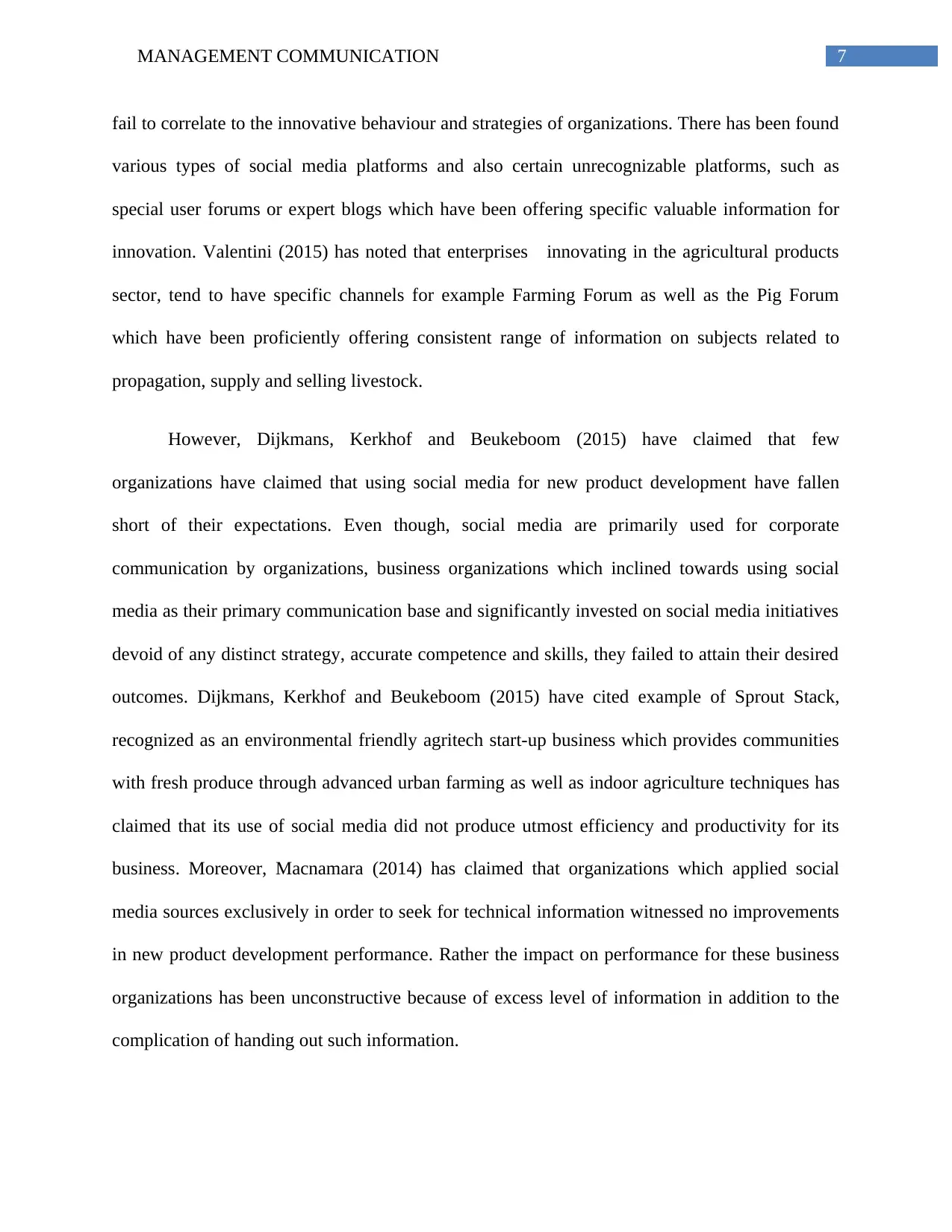
7MANAGEMENT COMMUNICATION
fail to correlate to the innovative behaviour and strategies of organizations. There has been found
various types of social media platforms and also certain unrecognizable platforms, such as
special user forums or expert blogs which have been offering specific valuable information for
innovation. Valentini (2015) has noted that enterprises innovating in the agricultural products
sector, tend to have specific channels for example Farming Forum as well as the Pig Forum
which have been proficiently offering consistent range of information on subjects related to
propagation, supply and selling livestock.
However, Dijkmans, Kerkhof and Beukeboom (2015) have claimed that few
organizations have claimed that using social media for new product development have fallen
short of their expectations. Even though, social media are primarily used for corporate
communication by organizations, business organizations which inclined towards using social
media as their primary communication base and significantly invested on social media initiatives
devoid of any distinct strategy, accurate competence and skills, they failed to attain their desired
outcomes. Dijkmans, Kerkhof and Beukeboom (2015) have cited example of Sprout Stack,
recognized as an environmental friendly agritech start-up business which provides communities
with fresh produce through advanced urban farming as well as indoor agriculture techniques has
claimed that its use of social media did not produce utmost efficiency and productivity for its
business. Moreover, Macnamara (2014) has claimed that organizations which applied social
media sources exclusively in order to seek for technical information witnessed no improvements
in new product development performance. Rather the impact on performance for these business
organizations has been unconstructive because of excess level of information in addition to the
complication of handing out such information.
fail to correlate to the innovative behaviour and strategies of organizations. There has been found
various types of social media platforms and also certain unrecognizable platforms, such as
special user forums or expert blogs which have been offering specific valuable information for
innovation. Valentini (2015) has noted that enterprises innovating in the agricultural products
sector, tend to have specific channels for example Farming Forum as well as the Pig Forum
which have been proficiently offering consistent range of information on subjects related to
propagation, supply and selling livestock.
However, Dijkmans, Kerkhof and Beukeboom (2015) have claimed that few
organizations have claimed that using social media for new product development have fallen
short of their expectations. Even though, social media are primarily used for corporate
communication by organizations, business organizations which inclined towards using social
media as their primary communication base and significantly invested on social media initiatives
devoid of any distinct strategy, accurate competence and skills, they failed to attain their desired
outcomes. Dijkmans, Kerkhof and Beukeboom (2015) have cited example of Sprout Stack,
recognized as an environmental friendly agritech start-up business which provides communities
with fresh produce through advanced urban farming as well as indoor agriculture techniques has
claimed that its use of social media did not produce utmost efficiency and productivity for its
business. Moreover, Macnamara (2014) has claimed that organizations which applied social
media sources exclusively in order to seek for technical information witnessed no improvements
in new product development performance. Rather the impact on performance for these business
organizations has been unconstructive because of excess level of information in addition to the
complication of handing out such information.
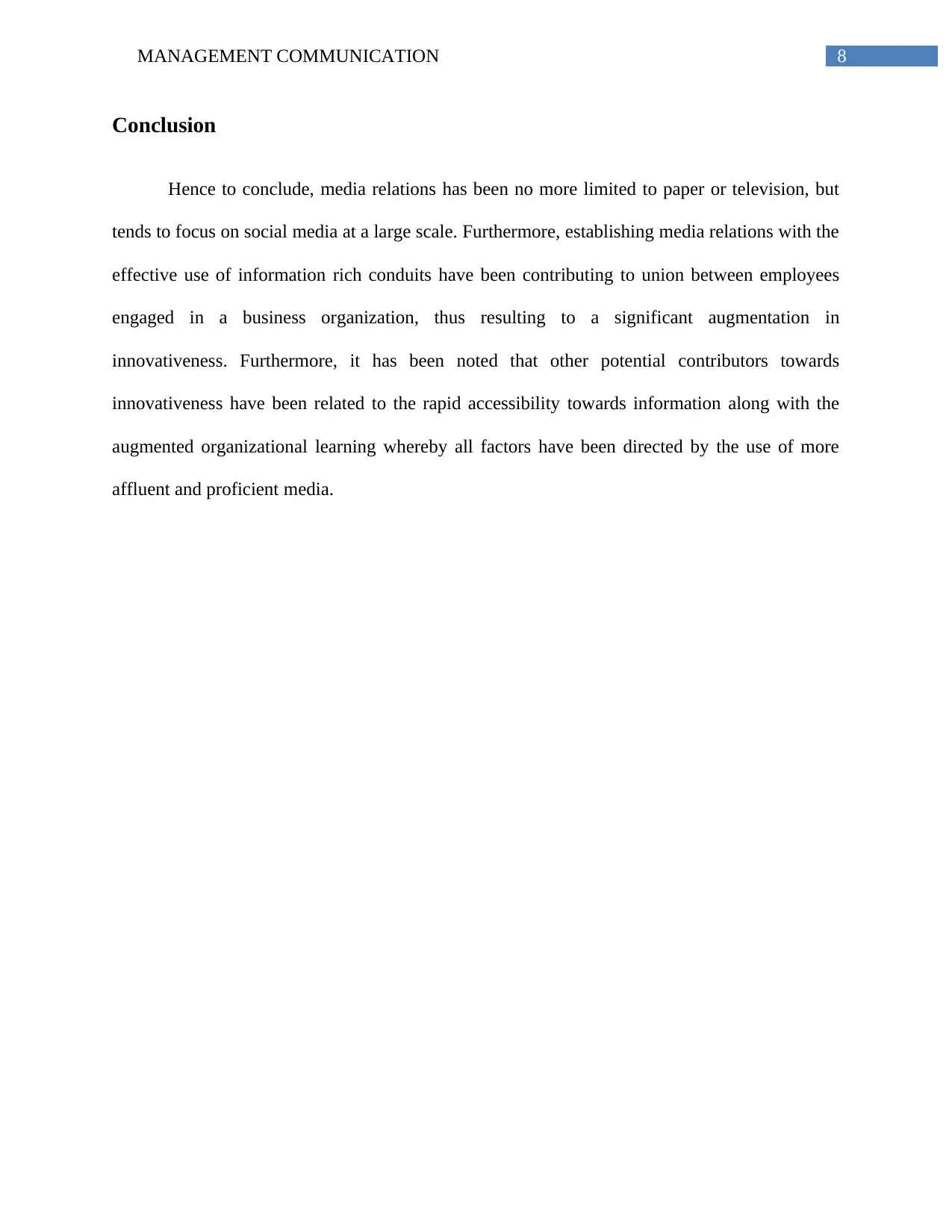
8MANAGEMENT COMMUNICATION
Conclusion
Hence to conclude, media relations has been no more limited to paper or television, but
tends to focus on social media at a large scale. Furthermore, establishing media relations with the
effective use of information rich conduits have been contributing to union between employees
engaged in a business organization, thus resulting to a significant augmentation in
innovativeness. Furthermore, it has been noted that other potential contributors towards
innovativeness have been related to the rapid accessibility towards information along with the
augmented organizational learning whereby all factors have been directed by the use of more
affluent and proficient media.
Conclusion
Hence to conclude, media relations has been no more limited to paper or television, but
tends to focus on social media at a large scale. Furthermore, establishing media relations with the
effective use of information rich conduits have been contributing to union between employees
engaged in a business organization, thus resulting to a significant augmentation in
innovativeness. Furthermore, it has been noted that other potential contributors towards
innovativeness have been related to the rapid accessibility towards information along with the
augmented organizational learning whereby all factors have been directed by the use of more
affluent and proficient media.
⊘ This is a preview!⊘
Do you want full access?
Subscribe today to unlock all pages.

Trusted by 1+ million students worldwide
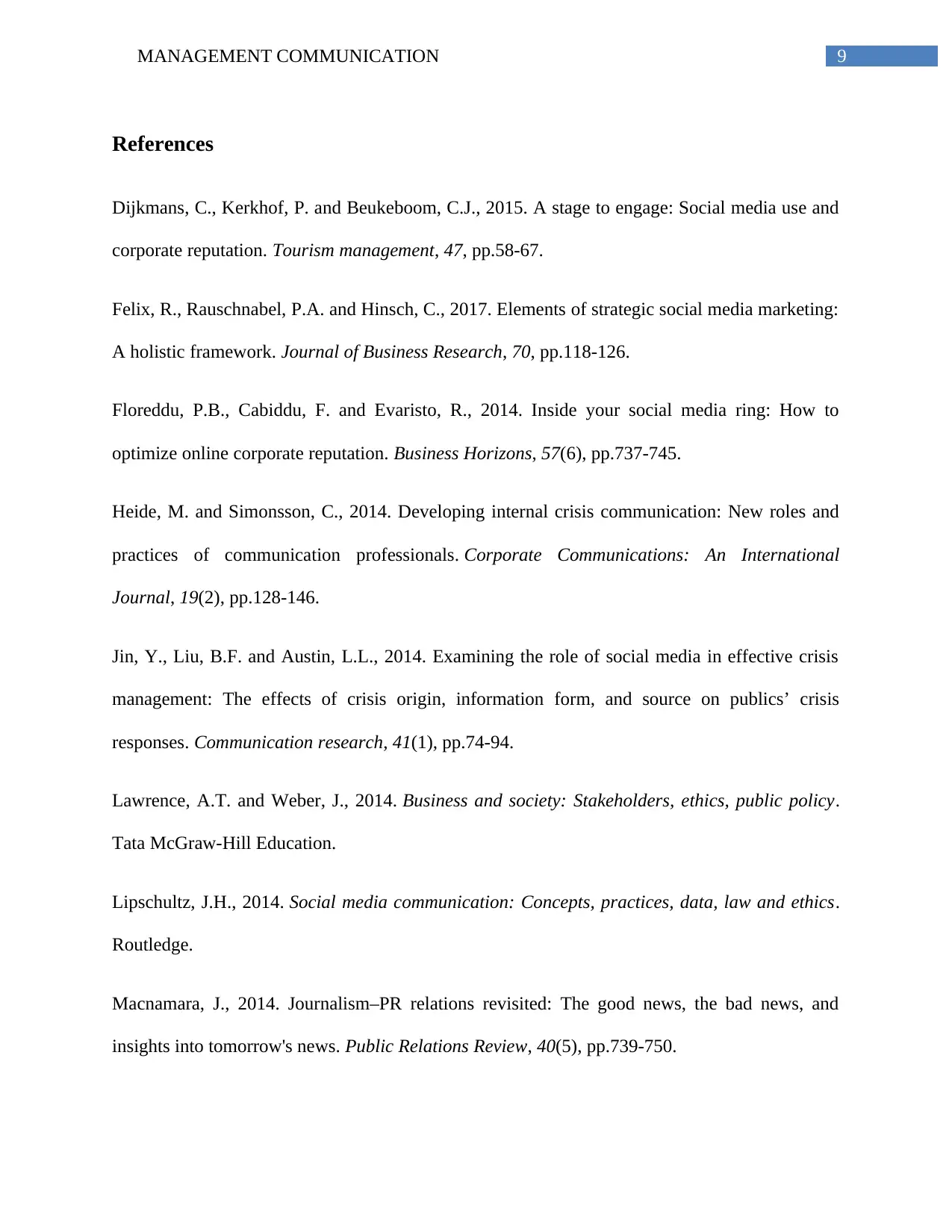
9MANAGEMENT COMMUNICATION
References
Dijkmans, C., Kerkhof, P. and Beukeboom, C.J., 2015. A stage to engage: Social media use and
corporate reputation. Tourism management, 47, pp.58-67.
Felix, R., Rauschnabel, P.A. and Hinsch, C., 2017. Elements of strategic social media marketing:
A holistic framework. Journal of Business Research, 70, pp.118-126.
Floreddu, P.B., Cabiddu, F. and Evaristo, R., 2014. Inside your social media ring: How to
optimize online corporate reputation. Business Horizons, 57(6), pp.737-745.
Heide, M. and Simonsson, C., 2014. Developing internal crisis communication: New roles and
practices of communication professionals. Corporate Communications: An International
Journal, 19(2), pp.128-146.
Jin, Y., Liu, B.F. and Austin, L.L., 2014. Examining the role of social media in effective crisis
management: The effects of crisis origin, information form, and source on publics’ crisis
responses. Communication research, 41(1), pp.74-94.
Lawrence, A.T. and Weber, J., 2014. Business and society: Stakeholders, ethics, public policy.
Tata McGraw-Hill Education.
Lipschultz, J.H., 2014. Social media communication: Concepts, practices, data, law and ethics.
Routledge.
Macnamara, J., 2014. Journalism–PR relations revisited: The good news, the bad news, and
insights into tomorrow's news. Public Relations Review, 40(5), pp.739-750.
References
Dijkmans, C., Kerkhof, P. and Beukeboom, C.J., 2015. A stage to engage: Social media use and
corporate reputation. Tourism management, 47, pp.58-67.
Felix, R., Rauschnabel, P.A. and Hinsch, C., 2017. Elements of strategic social media marketing:
A holistic framework. Journal of Business Research, 70, pp.118-126.
Floreddu, P.B., Cabiddu, F. and Evaristo, R., 2014. Inside your social media ring: How to
optimize online corporate reputation. Business Horizons, 57(6), pp.737-745.
Heide, M. and Simonsson, C., 2014. Developing internal crisis communication: New roles and
practices of communication professionals. Corporate Communications: An International
Journal, 19(2), pp.128-146.
Jin, Y., Liu, B.F. and Austin, L.L., 2014. Examining the role of social media in effective crisis
management: The effects of crisis origin, information form, and source on publics’ crisis
responses. Communication research, 41(1), pp.74-94.
Lawrence, A.T. and Weber, J., 2014. Business and society: Stakeholders, ethics, public policy.
Tata McGraw-Hill Education.
Lipschultz, J.H., 2014. Social media communication: Concepts, practices, data, law and ethics.
Routledge.
Macnamara, J., 2014. Journalism–PR relations revisited: The good news, the bad news, and
insights into tomorrow's news. Public Relations Review, 40(5), pp.739-750.
Paraphrase This Document
Need a fresh take? Get an instant paraphrase of this document with our AI Paraphraser
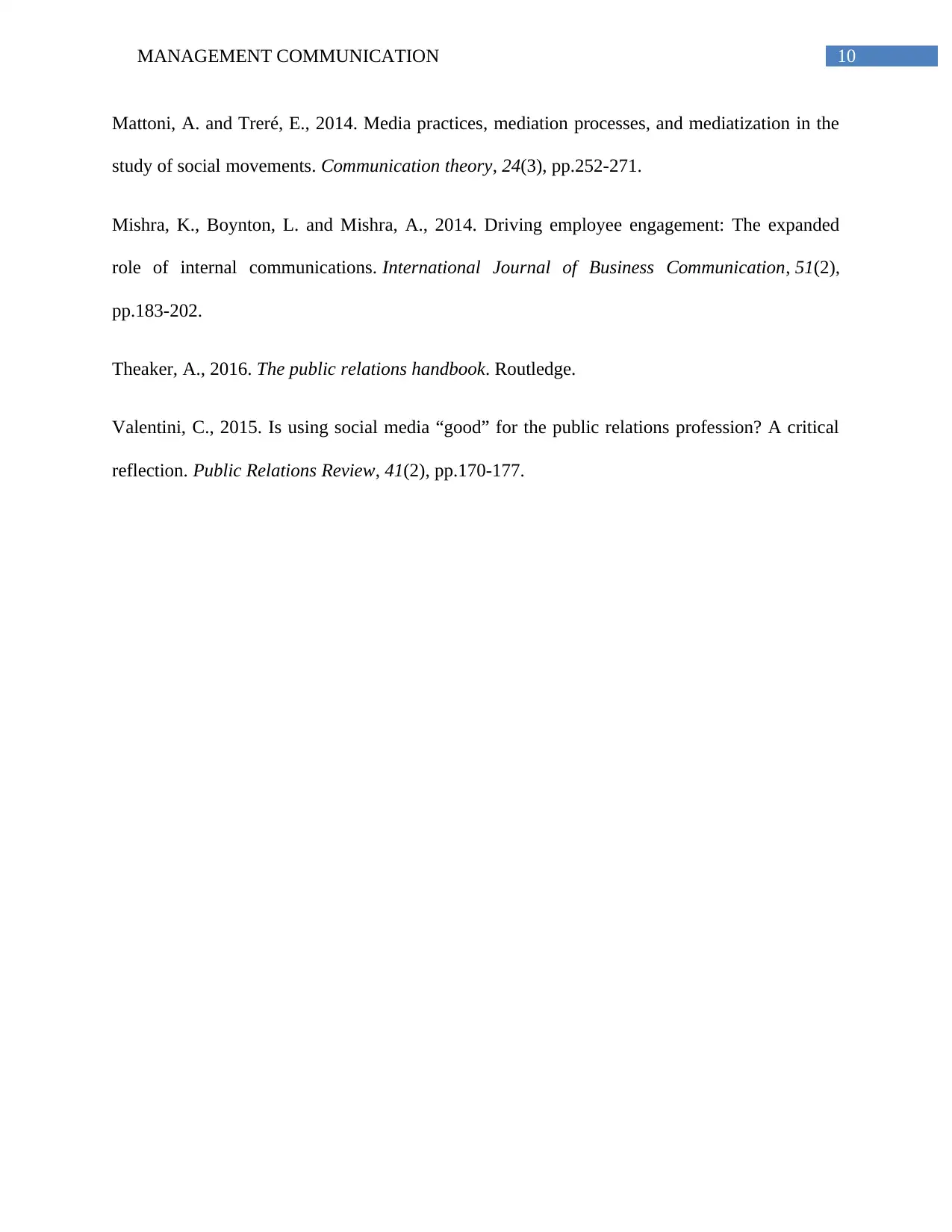
10MANAGEMENT COMMUNICATION
Mattoni, A. and Treré, E., 2014. Media practices, mediation processes, and mediatization in the
study of social movements. Communication theory, 24(3), pp.252-271.
Mishra, K., Boynton, L. and Mishra, A., 2014. Driving employee engagement: The expanded
role of internal communications. International Journal of Business Communication, 51(2),
pp.183-202.
Theaker, A., 2016. The public relations handbook. Routledge.
Valentini, C., 2015. Is using social media “good” for the public relations profession? A critical
reflection. Public Relations Review, 41(2), pp.170-177.
Mattoni, A. and Treré, E., 2014. Media practices, mediation processes, and mediatization in the
study of social movements. Communication theory, 24(3), pp.252-271.
Mishra, K., Boynton, L. and Mishra, A., 2014. Driving employee engagement: The expanded
role of internal communications. International Journal of Business Communication, 51(2),
pp.183-202.
Theaker, A., 2016. The public relations handbook. Routledge.
Valentini, C., 2015. Is using social media “good” for the public relations profession? A critical
reflection. Public Relations Review, 41(2), pp.170-177.
1 out of 11
Related Documents
Your All-in-One AI-Powered Toolkit for Academic Success.
+13062052269
info@desklib.com
Available 24*7 on WhatsApp / Email
![[object Object]](/_next/static/media/star-bottom.7253800d.svg)
Unlock your academic potential
Copyright © 2020–2025 A2Z Services. All Rights Reserved. Developed and managed by ZUCOL.




